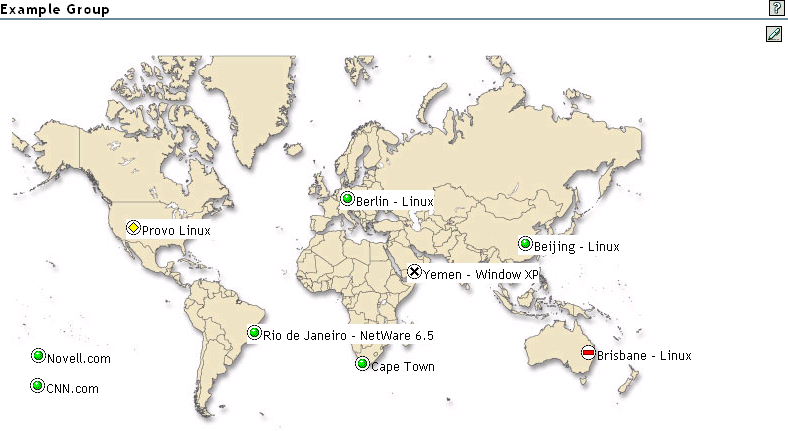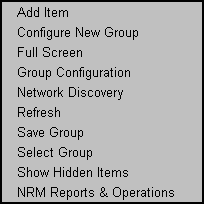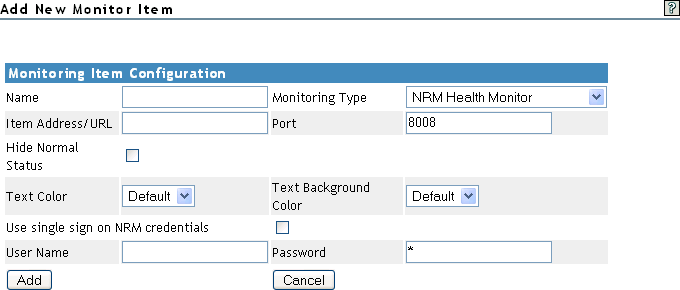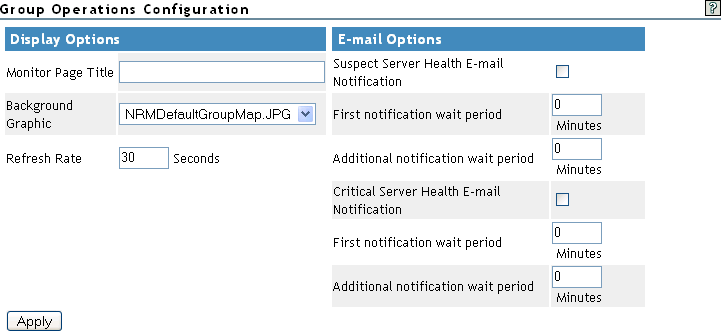12.1 Building and Configuring a Monitoring Group
Novell Remote Manager lets you build and configure groups of items for monitoring Linux server or NetWare server health, as well as providing various statistics for servers running other operating systems. A few of the preconfigured monitoring item types are NRM Health Status for a single server or a group of servers, Ping to a specific port, IP connectivity, LDAP Directory Root Search, and status of connectivity to a Web page.
Monitoring items can be defined and represented by an icons on a page as shown in the following figure. The icons can represent a single item or a group of items.
Figure 12-1 NRM Server Health Example Group

To build and configure a new monitor group:
-
Click the link in the navigation frame.
-
Right-click the Group Monitoring Operations page.
HINT:If your browser does not support right-click functionality, try double-clicking the Reports icon
 in the upper right corner of the page.
in the upper right corner of the page.
You should see a pop-up similar to the following:

-
Click , and do the following:
-
Complete the Monitoring Item Configuration form.

For each item you add to a group or want to change from the default setting (health monitor), complete the following options on the Monitoring Item Configuration form.
Option
Details
Specify one of the following types:
-
Label: Text information to use as a label on the group monitor display. Lets you identify each group specifically as needed.
-
LDAP Directory Root Search: Shows the response when trying to ping port 389 of the specified LDAP server. Credentials are not used. This is useful to monitor the status of your LDAP servers in your network.
-
NRM Group: Shows the health status of a group of servers. Lets you access the specific health page for each server in the group.
-
NRM Health Monitor: Shows the health status of each server in the group. Lets you access the specific health page for each server in the group.
-
Ping (ICMP): Shows the response when sending ping requests to the specified DNS name or IP address.
-
TCP/IP Port Query: Shows response activity of a designated TCP/IP service. This query attempts to make a TCP connection to the specified address and port. Returns green (good) health if any services is listening. For example, you could set up a health monitoring item to tell you whether your GroupWise server is still listening for logins from clients. The only states that are returned are green (good), which means the connection was successful, and red (bad), which means the connection was not successful.
-
Web page: Shows the response when trying to determine if the communication is working to a server that hosts a Web site. It does not monitor specific Web sites on the server. It does not monitor whether the Web service is running. Specify only the portion of the Web address (URL) that a DNS server can resolve to an IP address; do not include a subdirectory. For example, specify www.novell.com, but not www.novell.com/support. If you specify a subdirectory, the DNS name cannot be resolved, and a Can’t Connect health status is reported.
Name
Provide a descriptive name for the item.
Specify the IP address for the server that you want to monitor or ping, or specify the DNS name of the server that hosts the Web page.
The address can be an IP address or DNS name.
Do not specify the HTTP:// portion of a URL.
When selected, only items that are in an abnormal state are displayed.
If you want to monitor all statuses, leave the check box deselected.
Black is the default. You can select any other color from the drop-down list.
The default is provided. You can type a different port to use.
When selected (default), the credentials used to access this items' data are the same as the credentials that the user logged into Novell Remote Manager with.
When deselected, enter the credential necessary to access the item in the User Name and Password fields.
Clear is the default. You can select any other color in the drop-down list.
You can also define your own monitoring types or edit the default defined health types by editing the XML data in /opt/novell/nrm/NRMGroupHealthInfo file. For more information, see Defining or Editing Group Monitoring Types.
-
-
Click .
-
Drag the monitor items to the desired location.
-
Repeat Step 3.a through Step 3.c for each item that you add.
-
-
(Optional) If you want to change any of the following, change the configuration of the group:
-
The label for the group
-
The graphic displayed
-
The refresh rate
-
The suspect and critical email notification for the group
-
Right-click the customized Group page, then click .
-
Complete the fields as desired on the Group Operations Configuration form.

Option
Description
The display options let you control the following:
-
Monitor Page Title: Specify a title to be shown at the top of the monitor page in the header area when the page is built.
-
Refresh Rate: Specify the number of seconds between status queries to the server.
-
Background Graphic: Select a graphic from the drop-down list for the monitor items to be displayed on. This option can be helpful if you want to show specific locations of the item being monitored.
If you want to add a customized graphic, add it to the /opt/novell/nrm/NRMGroupMaps directory.
The email notification options control how and when email notifications are sent when the server health changes. Email notifications are sent to the addresses in the mail notification list using the mail servers set in the /etc/opt/novell/httpstkd.conf file.
-
-
Click .
-
-
Perform the desired task, or save the group and perform the task later.
In this release, the only task you can perform on Linux servers is to compare the server up times.
-
(Optional) If you want to reuse the group, save the group.
-
Right-click the customized Group page, then click .
We recommend using a name that represents the group you built.
-
(Conditional) If you haven’t saved any groups, you might need to extend the schema for NRM group operations before you can save the group.
Extending the schema is required only once per eDirectory tree. If the host is connected to a pre-existing NetWare 6.5 or later network, then extending the schema is not necessary.
-
Click and perform the required steps to save the group to a local server or save it and associate it with an eDirectory object.
See Saving a Group.
-